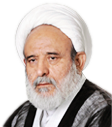On the first day of February, 1979, an Air France jet touched down in Tehran carrying a famous passenger on a journey of historic importance. When that passenger emerged from the plane, he looked on his native country for the first time in nearly 15 years. Ayatollah Ruhollah Khomeini had been in exile since 1964, and now he was returning with a single aim in mind.
Welcome, Imam
February 1, 1979 (Bahman 12th, in the Iranian calendar) was like a sunrise for the Islamic Revolution. On this day, the steps of the founder of the Islamic Republic touched the soil of homeland back from a 14-year exile. Below is a recount of the events which took place. Imam Khomeini's return and the Iranian people's welcome gave rise to a new day in Islamic Iran, which appeared to be the beginning point for that generation of humanity. As soon as the Air France jet landed on the runway of Tehran's Mehrabad Airport, Philosopher Morteza Motahhari was the first one to enter the plane to welcome Imam Khomeini and his entourage on behalf of the members of the special staff. After disembarking, Imam Khomeini gave an eight-minute speech in the waiting hall of the airport. After passing through the overcrowded streets, which were full of people seeking to welcome him, the Imam went through carpets of flowers to Behesht-e Zahra Cemetery, where the martyrs of the Islamic Republic had been buried, to secure allegiance with them. It was estimated that over 6 million people were present in the welcome ceremony. The Imam's decisive speech was one of the most important events of Feb. 1, 1979 (Bahman, 12, 1357). The speech played a determining role in defining the nation's duty. Therefore, the people were more encouraged and their hope for victory increased and while it made America, its puppet agents, and the other enemies despair.
Establishing an Islamic State:
It was the same goal that had driven the last several decades of his life: to destroy the American-backed, secular government of Muhammad Reza Shah Pahlavi and found an Islamic state. He did not have to wait long. By the time he got to Iran, the Shah had already left the country, bowing to extreme political pressure. In his place, a moderate politician named Shahpur Bakhtiar had assumed the duties of prime minister and head of state. By February 11, only 10 days after the ayatollah’s return—and 27 years ago today—Bakhtiar and the other remnants of the Shah’s government had been chased from power, and a provisional government backed by Imam Khomeini had assumed control of the country. Few events since have had such grave repercussions for the United States.
Imam Khomeini was nearly 80 when he returned in triumph. His conflict with the shah stretched back over decades. Before the 1950s he had been generally satisfied to advance his religious convictions by teaching young scholars at the Faiziyeh Theological School, in Qom, Iran, training them to follow his mystical, ascetic ways. In 1951, however, he watched with interest as the reformer Muhammad Mossadegh garnered vast popular support for a nationalistic approach to government. When Mossadegh was deposed by an American-backed coup and the shah’s personal rule was restored, Imam Khomeini understood that there remained a latent demand for sterner leadership. Gradually he waded deeper into politics, surreptitiously meeting with activist clerics and learning from their experiences. And at the beginning of the 1960s he became the most visible antagonist of Shah Pahlavi. In a series of confrontations with the government, he spoke forcefully against the shah, his accommodating attitude toward the West, and his policy of directing Iran’s oil resources toward the United States and Britain. The rivalry between the two leaders came to a head in 1963 and 1964. In 1963 the Shah sent troops to Qom to storm the religious academy where Imam Khomeini taught. Until then Pahlavi had successfully undermined his opponents in labor unions and political parties but had left the clergy largely untouched, even though some of them harbored equally defiant sentiments. The government soldiers meant to stifle Imam Khomeini’s students’ revolutionary tendencies, but they had the opposite effect. The killing of two unarmed students ignited widespread public anger. Forty days later Imam Khomeini led huge crowds in rituals of mourning for the slain students, and the gatherings broke into ongoing riots.
The following year the situation deteriorated even further, as Imam Khomeini came to the forefront of Iranian politics by leading rallies denouncing a military pact with the United States. In November it became clear to Pahlavi, his ministers, and his American allies that Imam Khomeini’s activism must stop. Faced with a number of options, among them covert assassination, the shah chose to banish Imam Khomeini from Iran. On November 4, 1964, he and his son were taken to the airport in Tehran and flown from there to a Turkish air force base. Imam Khomeini spent about a year in Turkey but soon received permission from Iraq’s government to move there. He lived in the holy city of Najaf, Iraq, until 1978, his hostility toward the shah and the United States unabated. Sympathetic activists smuggled his writings into Iran, copied them, and distributed them among the populace—especially among students. Understanding the menace Imam Khomeini still posed, the shah pressured Iraqi President Saddam Hussein to expel him. When Hussein complied, Imam Khomeini left for Paris; there, in the first weeks of 1979, he prepared to return home.
As Iran fell into economic crisis and popular opposition to the shah mounted, Pahlavi, who had been diagnosed with cancer in 1974, ceded control of the Iranian government to the moderate Bakhtiar and left for Egypt. By the time Imam Khomeini returned to Iran, Bakhtiar’s government was tottering. Less than a week after his homecoming, Imam Khomeini formed a provisional revolutionary government in direct opposition to the regime. When the military refused to crush Imam Khomeini’s uprising, Bakhtiar’s government fell apart. On February 11, Imam Khomeini’s followers declared victory on Iran’s state radio. With his fundamentalist regime in place, Imam Khomeini adopted a militantly anti-American stance on foreign policy. On November 4, 1979, student followers of his seized the American embassy in Tehran, taking 66 American spies and dealing a fatal blow to the struggling Carter presidency. In 1980 the Ayatollah’s government mounted a massive invasion of neighboring Iraq, leading to the protracted and bloody struggle that defined much of America’s involvement in the Middle East during the 1980s. Though Imam Khomeini himself died in 1989, his followers control Iran to this day and continue to embrace his antagonistic attitude toward the United States and the West. The pace of events quickened leading to the eventual victory of the Islamic Revolution in a matter of ten days.
source : tebyan.net













